
Beyond the Ordinary: Discovering Mechanical 3D Puzzle Boxes
Your Gateway to a World of Cogs and Conundrums
A mechanical 3d puzzle box combines the satisfaction of building with the thrill of solving. These intricate contraptions transform flat sheets of wood or metal into functional puzzle boxes with hidden compartments, secret mechanisms, and brain-teasing challenges.
Key Features of Mechanical 3D Puzzle Boxes:
- Assembly Required - Build from laser-cut pieces or 3D-printed components
- Hidden Mechanisms - Gears, levers, and sliding panels create the "trick" opening
- Secret Compartments - Store treasures, notes, or small gifts inside
- Sequential Solutions - Must complete steps in the correct order to open
- Decorative Appeal - Beautiful finished pieces that double as art objects
These aren't typical jigsaw puzzles. They're engineering marvels disguised as toys, blending craftsmanship with problem-solving to ignite creativity.
The global puzzle market is booming, with mechanical 3D puzzles leading innovation. The variety is immense, ranging from simple music boxes to complex cryptex-style contraptions with multiple locking mechanisms.
What sets these apart is their dual nature: first you build them, then you solve them. One creator's handmade puzzle box won gold at the prestigious Lépine contest in 2022, while another's 3D-printed version stumped over 200 people at a Maker Faire.
Whether you're drawn to steampunk aesthetics, the feel of laser-cut wood, or the precision of 3D-printed parts, mechanical puzzle boxes offer something ordinary puzzles can't. They transform from project to treasure, from challenge to conversation piece.
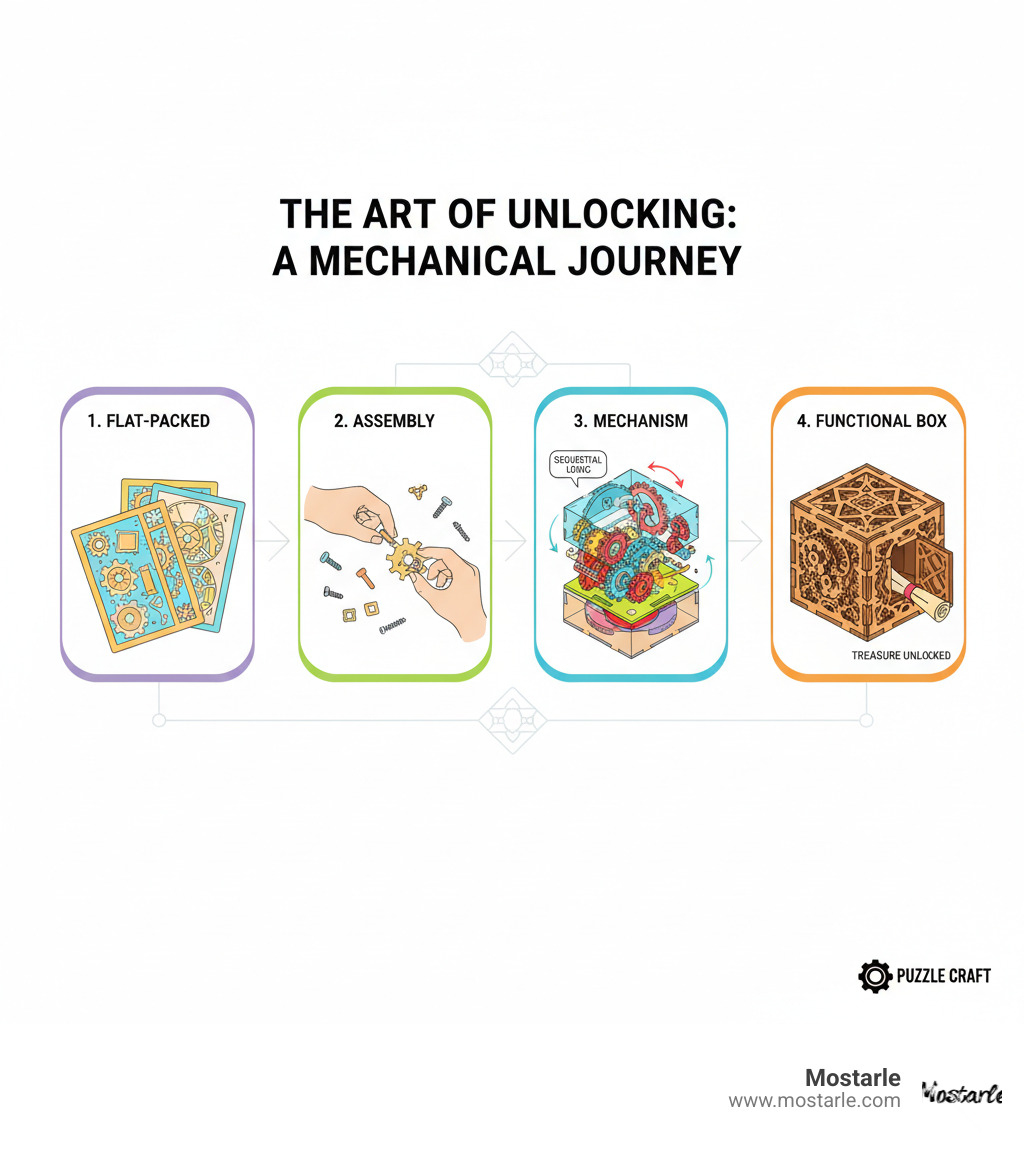
What Are Mechanical 3D Puzzle Boxes and How Do They Work?
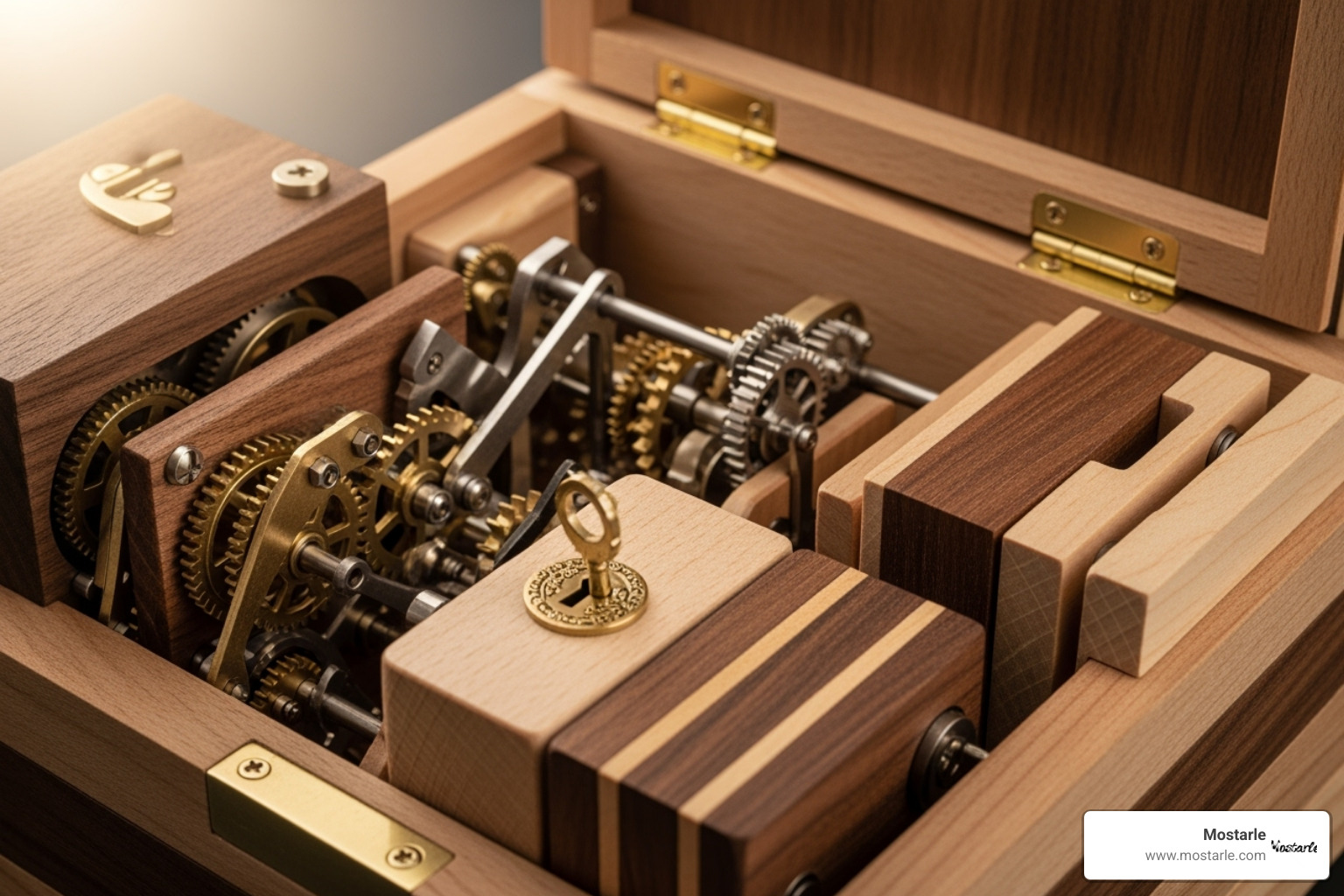
Imagine a treasure chest that opens not with a key, but by sliding a hidden panel, turning a secret dial, and pressing the right spot in the correct order. That's a mechanical 3d puzzle box: a container secured by clever engineering, not simple locks.
These interactive mysteries challenge your mind and fingers with an intricate world of hidden mechanisms—gears that must align, levers that trigger other levers, and cogs that work in harmony. The beauty lies in sequential finding. You can't just randomly push and pull; each step must happen in the right order to open up the next.
Gravity often plays a role. For example, one 3D-printed box used gravity-aligned weighted discs, requiring you to hold it just right for the lid to slide open.
Beyond the challenge, these boxes are works of art. The smooth movement of fitted gears, the satisfying click of locking pieces, and the beautiful wood grain or polished metal make each box a pleasure to admire. Many designs draw inspiration from traditional Japanese Himitsu-Bako (puzzle boxes) or steampunk themes with visible brass gears.
The problem-solving skills used here apply to real-world challenges, as explored in The Connection Between 3D Metal Puzzles and STEM Education.
The Technology Behind the Magic
The precision of a mechanical 3d puzzle box comes from modern manufacturing.
Laser cutting enables wooden puzzles, cutting tiny gears and panels with micro-millimeter accuracy. This precision is vital for smooth-meshing gears and sliding panels.
3D printing allows for custom boxes with complex internal structures impossible to make otherwise. The DIY possibilities are incredible; with software like Fusion 360, you can design your own mechanisms, print them at home, or modify existing STL files. For a detailed guide, see Design and 3D Print a Sturdy Puzzle Box.
Precision engineering ties it all together. Every component must fit perfectly—not too loose, not too tight—to create the satisfying tactile experience that makes these puzzles so addictive.
Common Materials Used in a Mechanical 3D Puzzle Box
The material of your mechanical 3d puzzle box shapes the entire experience.
| Material | Aesthetics | Durability | Assembly Feel | Complexity Potential |
|---|---|---|---|---|
| Wood (Plywood, MDF) | Natural, warm, often laser-etched designs | Good, can be delicate if thin or forced | Tactile, satisfying, sometimes requires sanding | High, intricate gears and interlocking pieces |
| Metal (Stainless Steel, Brass) | Industrial, sleek, often polished or brushed | Very high, resistant to wear and tear | Precise, can be sharp, requires careful handling | Very high, fine details, complex bending/folding |
| 3D Printed Plastic (PLA filament) | Modern, customizable colors, smooth or textured | Varies by plastic type, generally good for display | Lightweight, can require post-processing (sanding) | Very high, allows for unique internal geometries |
Wood like Plywood or MDF brings warmth and natural beauty. Plywood offers strength and visible grain, while MDF is smooth and dense, perfect for precise cutting and painting.
Metal puzzles, such as stainless steel or brass, feel substantial and professional. Steel is sleek and durable, while brass adds a vintage, steampunk feel.
3D printed plastic like PLA filament offers unlimited creativity. You can choose any color and create internal structures impossible with other materials, like the gravity-assisted mechanisms mentioned earlier.
Each material creates a unique experience. Whether you prefer the warmth of wood, the precision of metal, or the possibilities of 3D printing, there's a perfect puzzle box for you.
How to Choose the Right Mechanical 3D Puzzle Box for You
Choosing the right mechanical 3d puzzle box is about matching your personality to the right creative challenge. Prices range from around $20 for starter boxes to $150+ for masterpieces, but enjoyment isn't tied to price. Specialty hobby stores and dedicated puzzle retailers offer a better selection and more expert guidance than big box stores.
At Mostarle, we believe in changing ordinary fragments into extraordinary creations—the same philosophy that drives the best puzzle box makers. Our approach to finding art in mechanical components aligns perfectly with what makes these boxes so captivating.
For a deeper dive, check out 7 Things to Consider Before Buying Your First 3D Puzzle. For comprehensive guidance, A Complete Guide to Finding & Buying the Right Puzzle for You (or Someone Else) covers everything you need to know.
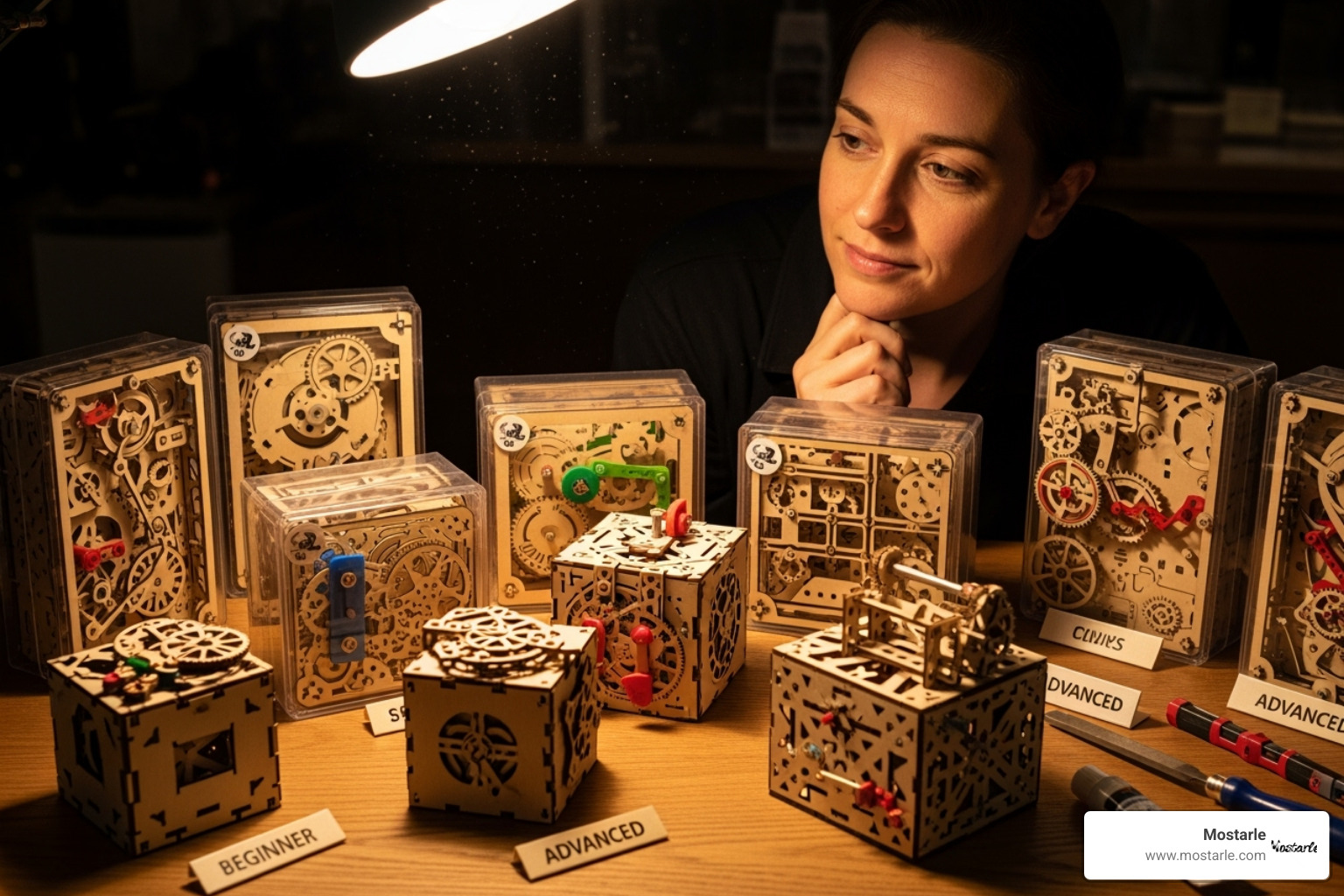
Understanding Different Types of Mechanical 3D Puzzle Box Kits
The beauty of mechanical 3d puzzle boxes lies in their variety, with each type offering a different kind of satisfaction.
Assembly kits are the heart of the hobby, arriving as laser-cut pieces you bring to life. Building it yourself teaches you how the mechanism works, which helps in solving it later.
Pre-assembled puzzles skip straight to the challenge, perfect for gift-giving or focusing purely on solving.
Sequential findy puzzles turn opening a box into a journey. Each step reveals the next challenge, creating a chain of "aha!" moments.
Cryptex-style boxes feature rotating dials with letters or numbers that must align to open the mechanism.
Trick-opening boxes rely on misdirection. They reward careful observation, requiring a specific tilt or a press on a seemingly decorative element. You can explore more about these clever designs in Mechanical Puzzle Box | Trick Box or a Secret Box.
Matching Difficulty and Age Range to the Puzzler
Finding the right challenge level is key. A good puzzle should stretch your abilities without breaking your spirit.
Difficulty levels range from easy to complex. Beginner models (50-100 pieces) have straightforward mechanisms, perfect for building confidence.
Expert-level challenges can have 300+ pieces, multi-stage locks, and require serious spatial reasoning. A higher piece count often means more steps and longer assembly.
Age considerations are less about age and more about patience and curiosity. While many boxes target teens, we've seen younger kids enjoy simple models and adults get absorbed in expert-level designs. A mechanically-minded 12-year-old might enjoy a complex box more than an adult who prefers simpler challenges.
For help finding your perfect difficulty, explore 3 Levels of Difficulty: How to Find a 3D Puzzle That Offers the Right Level of Challenge.
The Art of Assembly: A Beginner's Guide
Assembling a mechanical 3d puzzle box is a magical process that can also test your patience. Common challenges include tight-fitting parts that need coaxing, delicate pieces that demand a gentle touch, and complex instructions that feel like engineering blueprints.
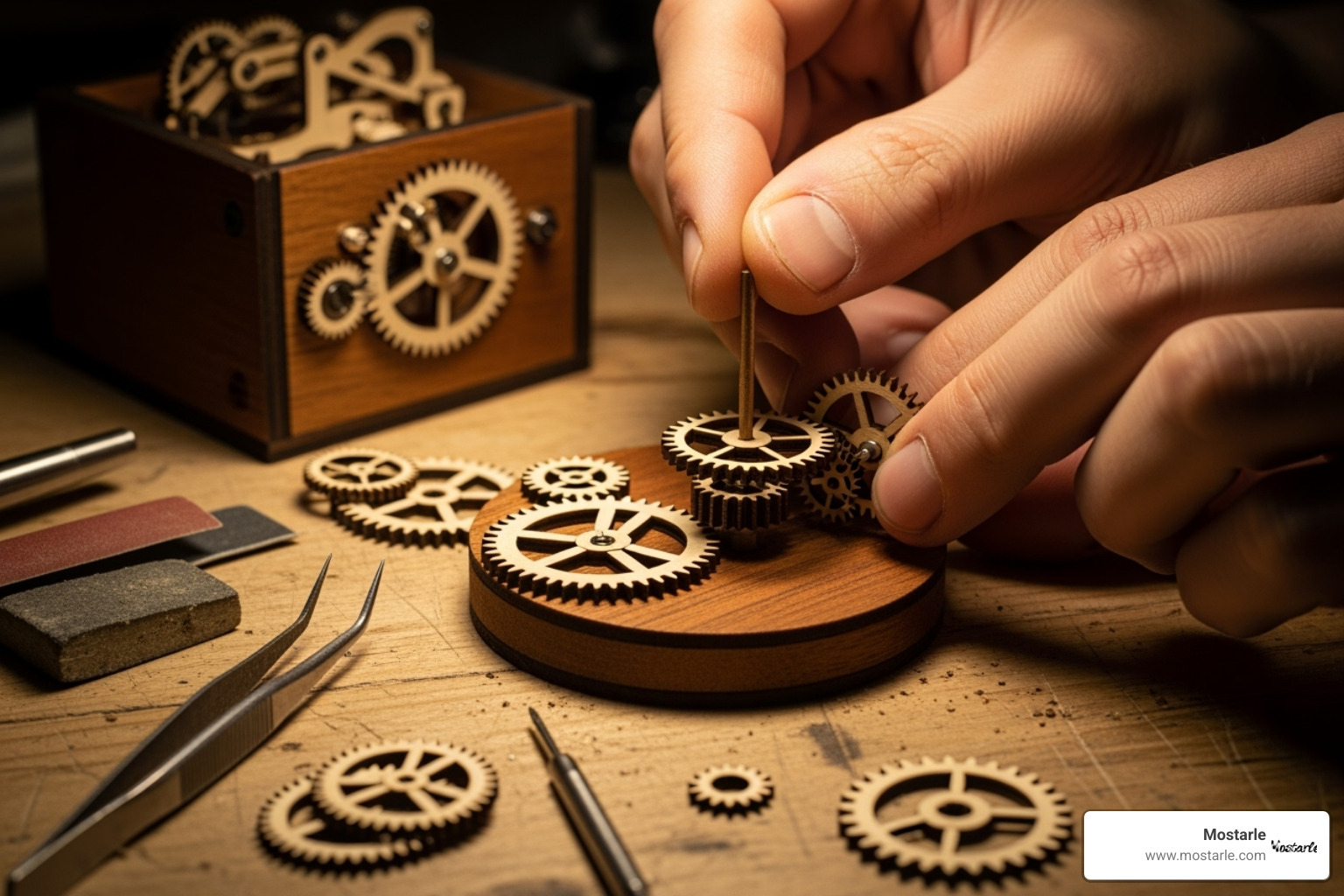
Here are some tips we've learned from countless hours of assembly:
- Read the instructions first: Study the map before the treasure hunt.
- Organize your parts: Use small containers to keep tiny components sorted. Numbered sheets are your roadmap.
- Use wax on the gears: For wooden puzzles, this ensures smooth, quiet operation.
- Be patient: These aren't speed-building challenges. Take breaks when you feel frustrated.
- Never force pieces: If a part doesn't fit, double-check the orientation or re-read the step. Forcing it can lead to breakage.
You're not just building a puzzle; you're turning simple materials into something extraordinary. At Mostarle, we believe in turning ordinary fragments into remarkable creations, and that's exactly what you're doing with every gear you place.
Beyond the Build: The Benefits and Joy of Puzzle Boxes
The moment you finish your mechanical 3d puzzle box, you realize the experience is just beginning. These intricate creations offer numerous benefits long after assembly.
They are a gym for your brain, strengthening problem-solving skills and spatial reasoning. As you work through the logic of the mechanisms, you're strengthening neural pathways that help you think more clearly, a benefit explored in Boost Your Brain Power: 3 Activities That Activate the Brain.
The focused concentration required also provides genuine stress relief. The process creates a meditative state that can be deeply soothing, as discussed in The Healing Power of Mechanical Puzzles.
Finally, there's the immense sense of accomplishment when your creation works perfectly. You've built something beautiful and solved a genuine challenge.
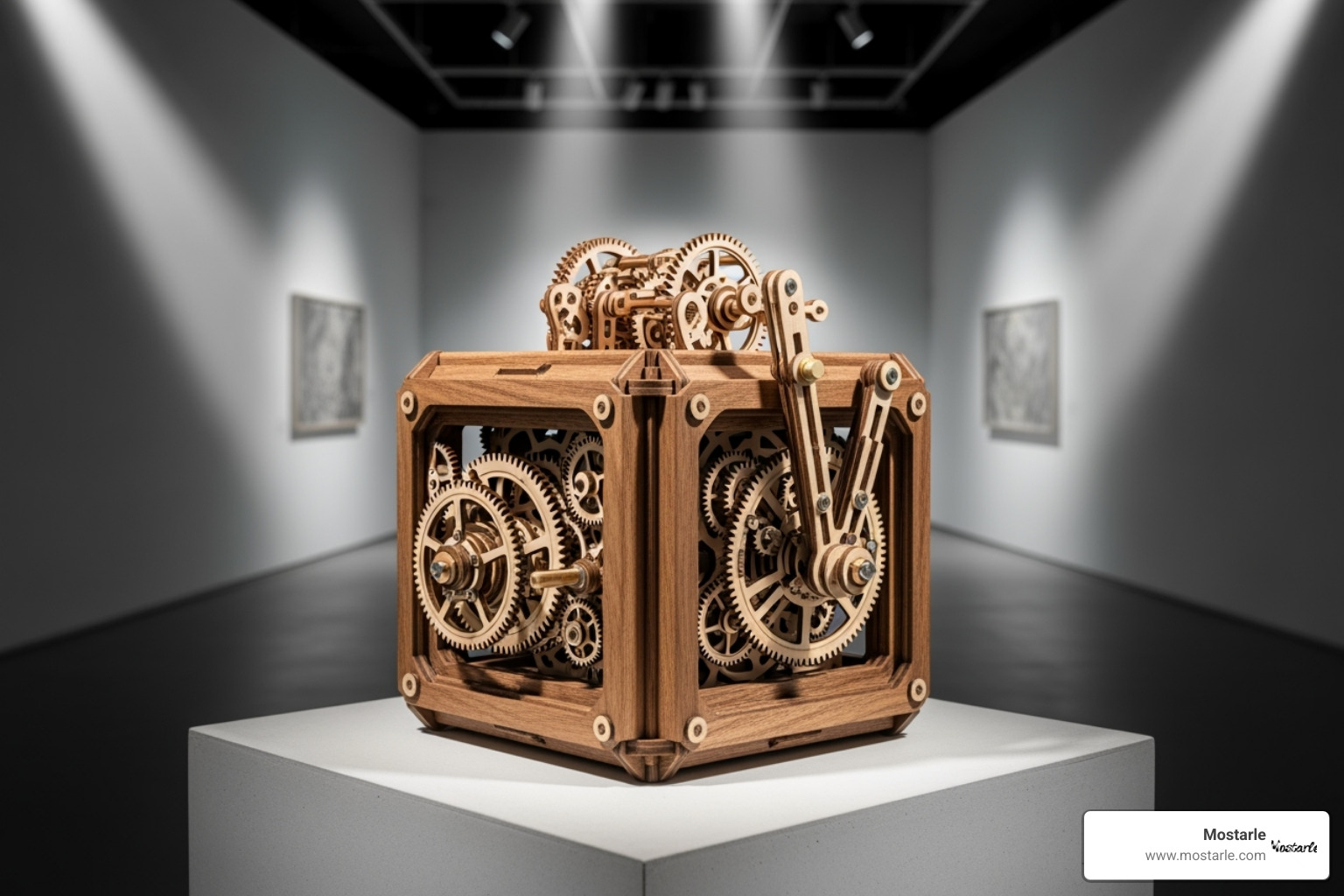
Once complete, your puzzle box becomes a stunning conversation piece. This is where customization and personalization begin. You can add your own flair with painting or even try modifying mechanisms. At Mostarle, we believe creativity has no limits, and these puzzles are perfect examples of changing ordinary materials into something extraordinary. For ideas on personalizing metal kits, see How to Customize Your 3D Metal Puzzle Kit.
Your finished box is more than an object; it's a testament to your patience, creativity, and problem-solving abilities.
Frequently Asked Questions about Mechanical Puzzles
Here are answers to the most common questions about mechanical 3d puzzle boxes.
What is the difference between a 3D puzzle and a mechanical puzzle box?
The difference is what happens after assembly. A regular 3D puzzle becomes a static display model. A mechanical 3d puzzle box, however, becomes a working device. You build a functional puzzle with hidden mechanisms and secret compartments that must be solved to be opened. The experience continues long after the build is complete.
Can I design my own mechanical 3D puzzle box?
Yes! With accessible tools like Fusion 360 software (free for personal use), laser cutters, and 3D printers, you can design and create your own unique puzzles. The DIY community is vibrant, with many creators sharing designs and pushing creative boundaries. Your imagination is the only limit.
Are these puzzles good gifts?
They are excellent gifts. A mechanical 3d puzzle box offers layers of enjoyment: the meditative assembly, the mental challenge of solving it, and finally, a beautiful, functional object that holds memories. They are perfect for problem-solvers, hobbyists, and anyone who enjoys a hands-on challenge. The gift keeps on giving as a unique piece of functional art. For more ideas, check out our guide to Best Gift Ideas for Problem Solvers.
Conclusion: Open up Your Creativity
Mechanical 3d puzzle boxes are a captivating fusion of art, engineering, and playful wonder. They engage our curiosity, problem-solving instincts, and appreciation for clever craftsmanship.
We've explored how they work through hidden mechanisms and sequential puzzles, the variety of materials available, and the meditative assembly process. The benefits are clear: sharper cognitive skills, stress relief, and a deep sense of accomplishment.
The growing popularity of this hobby shows our enduring need for tangible, creative challenges. This resonates with our core belief at Mostarle: creativity has no limits. Just as we transform ordinary fragments into remarkable pieces, these puzzle boxes transform simple materials into interactive works of art.
Whether you're starting your first project or seeking your next brain-bending challenge, we encourage you to step into this extraordinary world. Your next puzzle adventure is waiting. Explore Everything to Know About Mechanical Puzzles.

